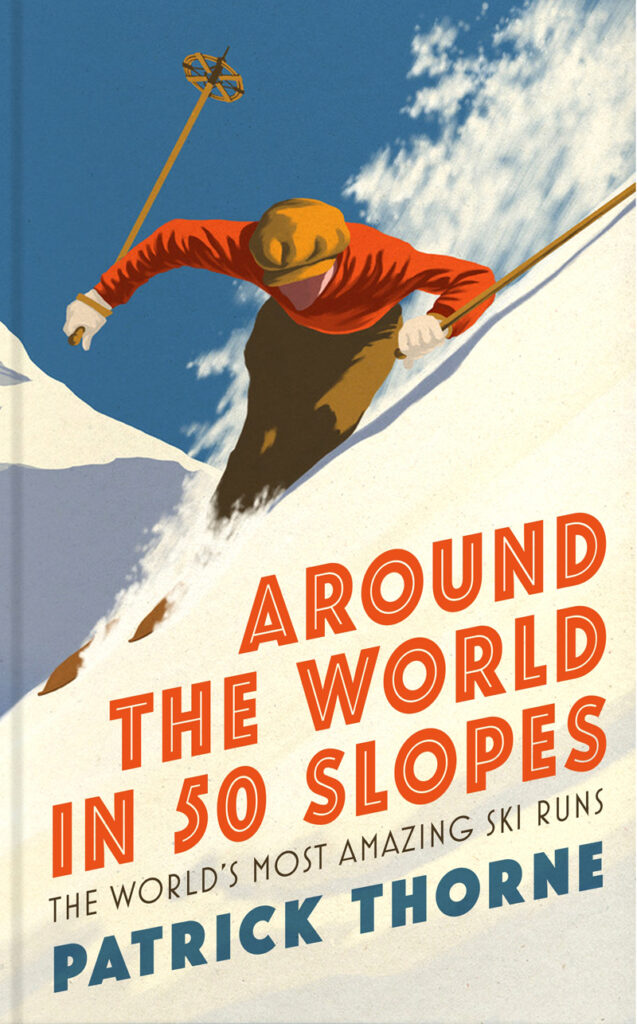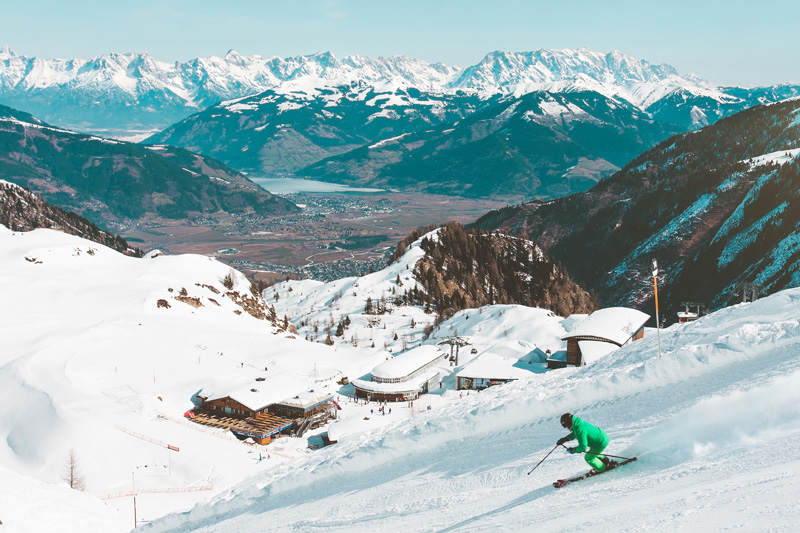As skiers and snowboarders turn their attention to the 2023 Alpine World Ski Championships this month, we speak to travel writer Patrick ‘The Snow Hunter’ Thorne about his latest book, Around the World in 50 Slopes, to discover the fascinating stories behind some of the world’s greatest runs…

Veteran snow travel writer Patrick Thorne, nicknamed ‘The Snow Hunter’, is believed to be one of the few people in the world to have made a living over nearly four decades as a year-round ski holiday travel writer and researcher. Over the years, he has written tens of thousands of ski news stories and articles for hundreds of global publications. The long-time editor of InTheSnow magazine, Patrick is the author of more than a dozen ski books. In the 1990s, in the pre-internet era, he sought to locate every ski area on earth, eventually finding more than 6,000 in 80 countries. In the 2010s, he went beyond mere earth-bound snow and researched snow on other moons and planets for his book Snow In Space
Patrick’s latest title, Around The World in 50 Slopes, takes skiers on a journey between ski runs located in 30 countries across six continents.
“There are lots of lists online covering the world’s steepest, most challenging runs and it’s normally the usual suspects, but I’m more interested in runs that have a story to them, an added dimension beyond just being great runs,” he says. “In short, I wanted to compile all the amazing stories I’ve been collecting over the past four decades.”
The runs take us to the world’s most northerly and southerly ski areas, to slopes skiable 365 days a year, or on the only slope for thousands of miles in southern Africa, down a volcano in the Andes or under the phenomenal northern lights. Some of the runs are important in the history of snow sports, marking key points in the evolution of many of the world’s great ski areas, including Mammoth Mountain, St Moritz and the Colorado run where (arguably) the first snowboarding competition took place.
Some of the more serious subjects raised include the development of ski areas to reverse rural depopulation, the battle by indigenous tribes to keep control of their ancestral lands (several opting to run their own ski areas), the connections between different religions and ski resorts, how former mining communities reinvented themselves thanks to ‘white gold’, the fight for gay rights, a ski area recovered from the Taliban, how some ski areas developed thanks to the growth of rail networks and even ski areas that developed thanks to mountain warfare training.
The climate emergency is another subject that Patrick, who also runs SaveOurSnow.com, and other skiers have witnessed first-hand. One famous run graphically illustrates the impact of melting glaciers.
So, as the 2023 Alpine World Ski Championships – one of the most important sporting events in the world of alpine skiing – prepare to take place in Méribel and Courchevel from 6 – 19 February, we speak to Patrick about his life’s work, the inspiration behind his new book and who to look out for when the world’s eyes turn to France this month.
Tell us about your background in the industry, where your love for skiing first began and what has kept you hooked…
My mum and dad got me on a school trip when I was 15, a long bus trip to Italy to stay in a hostel type place. I loved it from the start but I’d been crazy about sledging and all things snow since I was little my mum tells me. I think a good thing with skiing and boarding is you can have as much fun learning as when you get good. What has kept me hooked for 40 years? Well, I think the places and the people mostly. Lots of stunning, amazing places around the world and all inhabited by people who love the natural world, are open to all types, faiths, orientations just sharing a love of being in the mountains and the simple childhood fun of playing in snow.
What inspired you to write Around the World in 50 Slopes?
I think skiing and ski holidays are about much more than sliding as fast as you can down a hill and I’m very bored with traditional resort guides and clickbait website lists of “The 50 Best ski Runs” … which always go for the scariest options few people are capable of safely skiing. I think that skiing is pure, innocent fun – a way for us to connect to our childhood, so my first priority was to get runs in the book that most people can ski and will love. I have been writing about ski destinations for nearly 40 years, year-round, so you can imagine I have come across many different stories and I really just wanted to bring as many of them as I could into the book. I could have written about 10 volumes so I kept narrowing it down. I also wanted a geographic spread so ended up with the 50 runs coming from 30 countries on six continents with no more than half a dozen runs from any one country.
There are fun chapters tied to subjects like cheese, James Bond, The Beatles, Zeus, St Patrick’s day, St Valentine’s day, Count Dracula, Santa and the Northern Lights and many others, along with famous names in skiing through the decades where they’re tied to a particular place.
Ski areas are also places where big issues can be seen and addressed – international borders, religion, sexuality, climate change, depopulation of rural areas, indigenous land rights. The book isn’t too ‘heavy’ but I do try to bring these in too. (I could write a whole book on religion – everyone from past Popes to the Taliban have had views on skiing. Pope John Paul II was a good skier and his old ski jacket is now classed as a Holy relic because he’s been made a saint.)
What is one of your favourite stories that you discovered while writing the book?
I have written tens of thousands of ski news stories over the decades so, for me, the best thing writing the book was to select the best of them and bring different stories together. For example, there are lots of different James Bond skiing connections from the first snowboarding on screen when Roger Moore pretended to take a sled off a snowmobile and board with it, or the scene where he skis off a cliff with a union jack parachute opening up, to Ian Fleming being based in Kitzbuhel a century ago to Daniel Craig in the Austrian resort of Solden in Spectre. So it was quite cathartic for me to bring all these separate stories from my brain into one chapter.
Why did you decide to set up Save Our Snow in 2004?
I have followed ski resort developments and skied myself since the 1970s and I noticed that there was a change in the late 1990s when resorts stopped talking about expanding and instead spent on snowmaking, I also returned to glaciers I’d skied five or 10 years before and saw they were disappearing. In the early 2000s, newspapers started saying: “if you care about the environment make sure you check what your chosen ski resort is doing before you travel there” … but there wasn’t an easy way to find that out so the original idea was to provide concise information on the environmental efforts of ski resorts.
What has it been like witnessing the climate emergency first-hand and what have you noticed in particular over the last 30 years in terms of the way ski resorts are addressing their impact and implementing environmental initiatives?
Back in the 1980s and 90s it was clear the ‘old guard’ running ski resorts then found environmental campaigns an annoyance and irrelevance in many places. Now those campaigners are employed by the resorts and they almost always consider the environment, normally reducing their current impact each time they make a decision. They’ll replace four old inefficient lifts with one new one that uses a fraction of the energy, often generated on-site with renewables. It’s a 180-degree shift in attitude.
Many now invest in onsite green power sources. Those that are ahead of the game are well placed to handle the energy price hikes this year, so it’s nice they’re being rewarded for their eco efforts.
What are your predictions for the World Ski Championships in February? Who should audiences look out for? I guess Marco Odermatt is most exciting of the new generation, will be odd without Beat Feuz. I’m most excited about Mikaela Shiffrin, finally (though I don’t want to jinx her) becoming the all-time number one World Cup winner overtaking Ingemark Stenmark’s over three-decades-old record of 86 wins. She’s up to 83 at time of writing, the last six in the past month.
Where is usually good to ski and board in February and March?
I’m hoping Austria in March as I have a trip booked, but most places should be good by then. It’s a bit of a way, especially if you’re watching your carbon footprint, but the US West Coast, particularly California, has had the most snow in the world so far this year – it’s five metres deep at Mammoth Mountain already.
Having visited thousands of ski areas around the world, which area should skiers add to their bucket lists?
Too many! I am a sucker for stunning scenery so the Canadian rockies, Niseko in Japan with Mt Yotei, the Matterhorn above Zermatt and the Scottish west coast from the Nevis Range are all phenomenal. But I like the saying a great ski filmmaker Warren Miller repeated, “the best run is your next run” wherever you are. That’s very true.
What is your most memorable moment in the mountains so far?
That would be 1986 in Aviemore, Scotland, on a college ski trip I organised. We couldn’t afford lift passes so my new girlfriend and wife-to-be Sally stood on the back of my skis as I slid down a gentle slope. That shaped my whole life.
Around The World in 50 Slopes by Patrick Thorne is available now in bookshops and online | £16.99



